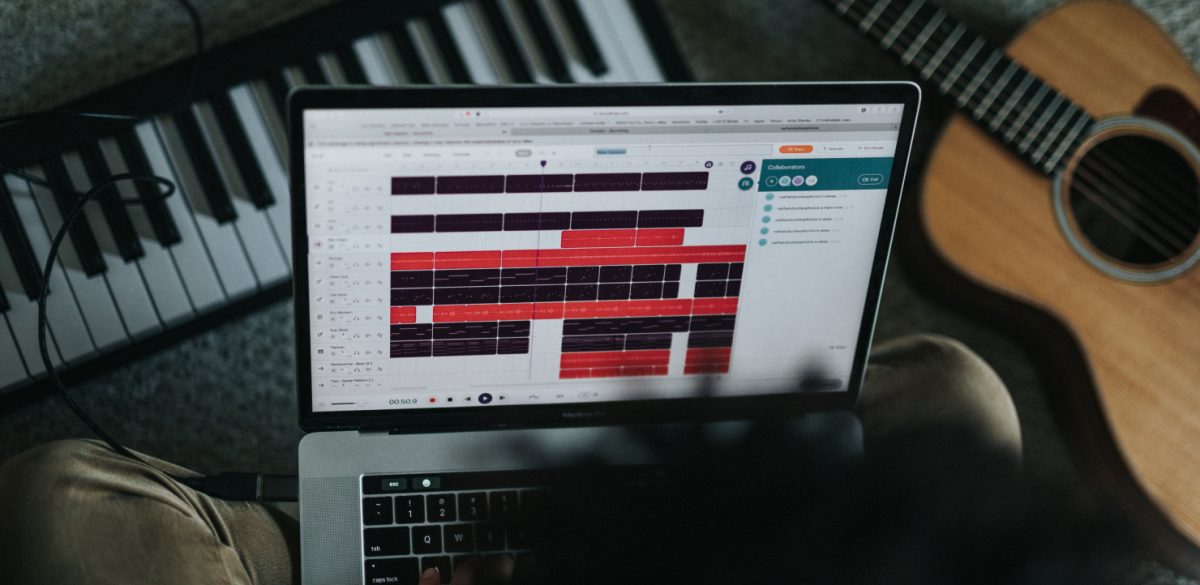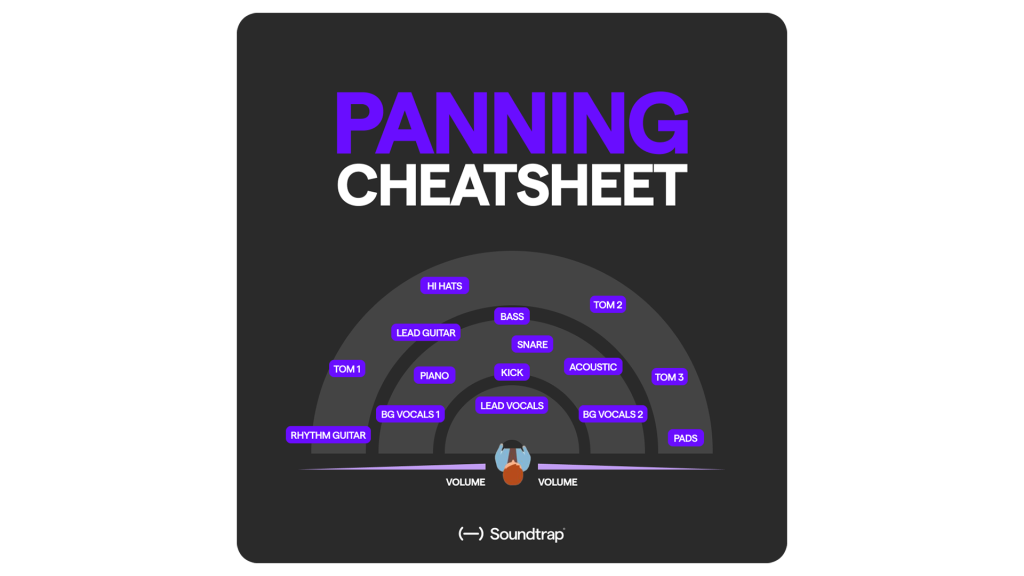
What Is Panning In Music Mixing? Tips And Techniques
May 7, 2024
-
Anton Berner
Discover the art of panning in music mixing—shaping your sound's spatial landscape with precision and creativity. Learn essential techniques to better your mixing.
Panning in music is a creative and crucial technique that you can use to shape your musical soundscape.
It involves distributing different audio elements across the stereo field, which is the aural space between your left and right speakers or headphones. When you pan a sound, you decide where that sound should sit in the stereo image, giving it a specific location ranging from the far left to the center and over to the far right.
As simple as this sounds, I can tell you it’s one of the most important mix decisions you make. It’s not just an artistic choice; it’s a practical approach to preventing different instruments or vocals from clashing and making sure each has its own distinct space.
In audio production, panning is a crucial tool that helps create a sense of width and depth, making your tracks more immersive.
When combined with reverb and delay effects, panning can transform a flat, lifeless mix into a dynamic, three-dimensional experience for the listener.
Every track in your mix needs attention to panning—even if it’s to be placed centrally. It gives each sound room to breathe and can highlight certain elements, making crucial parts of your song stand out or providing a more balanced mix.
Understanding how to use audio panning effectively is essential for a music producer or mixing engineer.
It’s not just about left or right placement; it’s also about how sounds interact with each other in the stereo field. The interplay of panned sounds can create movement and excitement in your music, drawing listeners into a more engaging audio environment.
Think of panning as an artist would think of arranging elements in a painting—where you place the instruments in your mix can tell a unique auditory story, helping you captivate your audience with every note.
Fundamentals of Panning in Music
Panning is an essential tool in music production that allows you to place sound elements across the stereo field to create width and depth. It transforms a mix, giving each element its distinctive spatial location.
Understanding Stereo Sound
When you listen to music through headphones or speakers, you’re experiencing stereo sound. This means that you have two separate audio tracks: one for the left channel and one for the right channel.
During mixing, producers use panning to determine where a sound falls within this left-right spectrum. If you pan a sound to the left, it will be louder in the left speaker, and if you pan it to the right, it will be louder in the right speaker. A center pan keeps the audio evenly distributed between both.
Panning can be applied the same whether you’re working with mono or stereo tracks.
The Role of Pan Law
Pan law is a fundamental concept that ensures the perceived loudness of a sound remains consistent as it moves from side to side across a stereo field.
As you pan a sound from the center to one side, the volume is reduced slightly to compensate for the acoustic power that would otherwise increase due to sound coming from both speakers when panned center. Different digital audio workstations (DAWs) may use different pan laws, usually measured in dB (decibels).
Panning Techniques and Applications
Hard Panning and Its Uses
Hard panning is when you pan a sound to the extreme left or right of the stereo field using the audio pan pot.
This technique is a great way to create a wide stereo image and make room for different elements within a mix. It’s particularly effective in genres with many layers, such as rock or orchestral music, where clear separation can prevent a muddy mix.
You might use hard panning for:
-
Double-tracked guitars, placing one hard left and the other hard right.
-
Backing vocals to enhance the width and complement the lead vocal centered in the mix.
LCR Panning
LCR panning stands for Left-Center-Right panning, a simplified approach where you place elements strictly in one of the three positions.
Left
Instruments or elements that you want to be perceived from the left side, or sounds that counterbalance elements panned to the right for symmetry.
Center
Typically reserved for the most important elements such as lead vocals, bass, kick drum, and snare.
Right
Instruments of elements that you want to be perceived from the right side, or sounds that counterbalance elements panned to the left for symmetry.
Creative Panning
Panning can also be used as an audio effect. You can hear this in many different genres of music, especially in modern electronic styles.
Auto-panning
Use this to rhythmically move a sound between the left and right channels, often applied to synths or percussion for a dynamic effect.
Automated panning
You can change panning positions throughout the song to maintain balance or create movement—for instance, widening the mix during a chorus.
Practical Panning for Instrumentation
When crafting a balanced mix, the strategic placement of each instrument within the stereo field can greatly enhance the clarity and dynamic of your song.
Panning Drums and Percussion
Drums and percussion are the heartbeat of most tracks, and thoughtful panning is crucial.
Your kick drum should generally be panned center to anchor the mix with its low-end power.
Similarly, the snare drum tends to stay in the middle, providing a consistent backbeat.
The one exception to this snare drum pan rule is if you’re mixing a real drum kit, or you want your drums to sound like one. Then you’d need to decide the listeners perspective: the audience, or the drummer.
Personally, I prefer to mix the kit from the audience’s perspective as that’s how any listener would naturally hear the performance if it was live. So in that instance, I would pan the snare drum slightly right of center.
For stereo imaging, high toms can be panned slightly off-center to each side to reflect their physical positioning in a real drum kit. Again, the above listener perspective decision you made would dictate which side you should pan each tom.
The Stereo Placement of Guitars
Acoustic guitars can benefit from a wider stereo spread, giving your mix an airy, open quality. Place them moderately to one side if they are the main rhythm instrument. With a single acoustic guitar, moderate pan to one side typically works well.
With electric guitars, especially when you have multiple layers, try contrasting panning. If one guitar is panned 20% left, pan another layer 20% right to create balance and avoid frequency masking.
Doubling acoustic or electric guitars with another take and panning each track to opposite sides for layers will give your guitars wider, more powerful sound.
Managing Low-Frequency Instruments
Instruments like the bass guitar are typically centered in the mix. This central placement ensures that the low frequencies, which are non-directional to the human ear, are evenly distributed and maintain their power across different listening environments.
Even if you use a stereo synth bass, I recommend using a plugin to convert it into mono and keep the panning in the center.
Crafting the Vocal Space
Positioning Lead Vocals
When dealing with lead vocals, your main vocal should typically be panned at center. This ensures that the vocal holds a prominent and focused position in the mix.
Panning your main vocal dead center allows it to cut through the instrumentation, ensuring it remains your listeners’ focal point.
Layering Background Vocals
For background vocals, panning can help to create a richer, more enveloping experience.
Background vocals should usually be panned to create stereo width, which can be achieved by distributing them from slightly left to right of the center.
You might pan background vocals like this:
-
Left 30% – Background Vocal 1
-
Right 30% – Background Vocal 2
-
Left 50% – Additional Layers or Harmonies
-
Right 50% – Corresponding Layers or Harmonies
By spreading the background vocals across the stereo field, you not only add depth to the mix but also help to surround the listener with a vocal atmosphere that supports the lead vocal without overpowering it.

Here is a diagram showing popular ways to pan your instruments in the stereo field
Panning in Your DAW
All modern DAWs come with controls for panning your tracks.
In Soundtrap, you can find the Pan control knob by clicking the track icon; here, you’ll see the controls for Reverb, Pan and Volume.
Try adjusting the Pan knob until the sound is positioned where you’d like to hear it within the stereo field.
Soundtrap also has an Auto Pan plugin that you can use for more creative effect.
Mixing and Mastering Considerations
When you are in the final stages of mixing and mastering your track, it’s crucial to focus on achieving a balance and creating a stereo mix that sounds cohesive.
Achieving Balance and Clarity
In pursuit of a well-balanced mix, your aim should be to position elements so that they don’t compete for the same stereo space.
Level Adjustments
Start by setting appropriate levels for each track. Remember to leave headroom for mastering.
EQ
Use equalization to carve out a unique space for each element, which helps in reducing frequency masking.
Panning Decisions
Consider the phantom centre for elements that need focus, like vocals. Move supporting elements to the sides but ensure the mix remains balanced.
Mono Compatibility
Here’s one of my most important final panning tips when mixing: Check your final mix decisions in mono.
Sometimes panning elements hard left and right might sound great in stereo, but the elements disappear in the mix when heard in mono. A clear and well balanced mix will work just as well in mono as it does in stereo.
Why is this important you say? There are many situations where your mix might be played in mono for various reasons; restrictions of the streaming speed or the device it’s played back both can cause the audio to come out in mono.
The Final Steps to Stereo Cohesion
Reference Tracks
You should compare your mix against industry-standard tracks to gauge stereo width and balance.
I always use reference tracks to finish my mixes. This gives me a point of reference on what the final balance and sound of the mix should be like within the genre I’m working in.
Automation
Use subtle volume and panning automation to keep dynamic elements engaging throughout the mix.
Stereo Imaging Tools
Utilize stereo imaging plug-ins to enhance the sense of space.
Professional Input
If possible, get feedback from sound engineers and industry professionals for unbiased opinions on your final mix.
Conclusion
Panning in music mixing is a fundamental technique used to sculpt the stereo image of your tracks, shaping the spatial placement of audio elements between the left and right channels.
I know it may seem like such a simple adjustment, but panning is an essential tool that not only adds depth and width to your mix but also ensures clarity and balance by preventing sonic clashes between instruments and vocals.
By strategically distributing sounds across the stereo field, you can create an immersive listening experience, enhancing the overall dynamics of the composition.
When you start learning how to use panning in your mixes, keep in mind that achieving the best results in your mix is a process that takes time, patience, and a keen ear.


